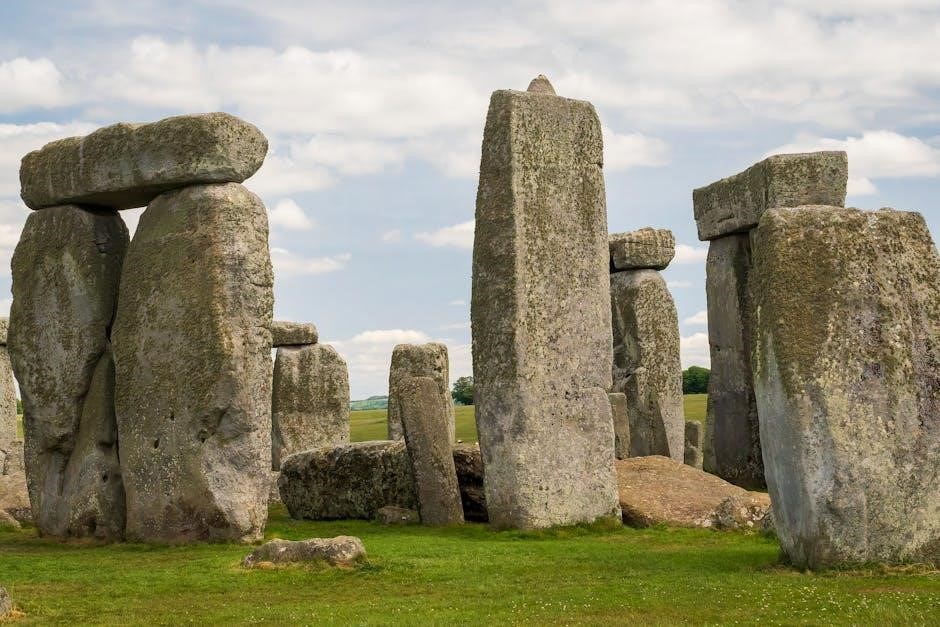Restorative circle questions are a powerful tool fostering dialogue, reflection, and mutual understanding in various settings․ They promote equity, respect, and connection, guiding participants toward meaningful conversations․
What Are Restorative Circles?
Restorative circles are structured processes where participants sit in a circle to discuss topics, fostering dialogue and reflection․ They often involve an inner and outer circle, with the inner circle focusing on specific issues while the outer circle observes․ These circles are facilitated by a trained Circle Keeper, ensuring equitable participation․ Rooted in indigenous practices, restorative circles emphasize equality, inclusivity, and collective problem-solving․ They are widely used in schools, communities, and organizations to address conflicts, build trust, and strengthen relationships․
Why Are Restorative Circle Questions Important?
Restorative circle questions are essential for fostering meaningful dialogue and reflection․ They help resolve conflicts, build trust, and strengthen relationships by encouraging active listening and empathy․ These questions promote accountability, understanding, and collective problem-solving, creating a safe space for participants to share perspectives․ By addressing emotional and social needs, restorative circles empower individuals to take responsibility for their actions and work collaboratively toward solutions․ This approach cultivates a sense of community and belonging, making it a vital tool in educational and organizational settings․

Types of Restorative Circle Questions
Restorative circle questions include clarification, affective, and reflective inquiries․ These categories foster understanding, explore emotions, and encourage deeper insights, promoting meaningful dialogue and connection among participants․
Clarification Questions
Clarification questions seek to gather information and ensure understanding․ Examples include asking about the frequency of an event or who was involved․ These questions help participants provide details, making discussions more informed and focused․ They are often used in problem-solving circles to address incidents by uncovering facts and contexts․ By asking “when” or “how,” they guide the conversation toward actionable solutions, ensuring everyone has a clear picture of the situation at hand․
Affective Questions
Affective questions focus on emotions and perspectives, encouraging participants to share their feelings and needs․ They explore how incidents have impacted individuals and others, fostering empathy and understanding․ Examples include, “How has this affected you?” or “What have you thought about since?” These questions create space for emotional expression, helping to build connections and address underlying concerns․ By focusing on emotional experiences, they promote healing and constructive dialogue, making restorative circles more meaningful and impactful for all involved․ They are essential for creating empathy and understanding in restorative processes․
Reflective Questions
Reflective questions encourage participants to think deeply about their actions, decisions, and experiences․ They help individuals analyze their role in a situation and consider its broader impact․ Examples include, “What have you learned from this?” or “How might you approach this differently in the future?” These questions promote personal growth and accountability, guiding individuals toward understanding the consequences of their actions․ By fostering self-reflection, they support healing and the development of more thoughtful and responsible behavior in restorative circles․ They are crucial for personal development and accountability․
Structure of a Restorative Circle
A restorative circle follows a structured format, beginning with opening questions, proceeding through mid-circle reflections, and concluding with closing statements to ensure thoughtful dialogue and resolution․
Opening Questions
Opening questions in a restorative circle are designed to set the tone, establish trust, and encourage participation․ They often focus on shared experiences, emotions, or perspectives, helping to create a safe space for dialogue; Examples include inquiries about strengths, challenges, or hopes related to the topic․ These questions lay the foundation for meaningful conversations, ensuring all voices are heard and valued․ The circle keeper plays a key role in selecting prompts that align with the circle’s purpose and foster connection among participants․
Mid-Circle Questions
Mid-circle questions deepen discussion and exploration, encouraging participants to reflect on their experiences and perspectives․ These questions often seek insights into thoughts, feelings, and impacts, helping to uncover common ground and shared understanding․ They guide the group toward empathy and collective problem-solving, ensuring the conversation remains focused and meaningful․ Effective mid-circle prompts can include inquiries about personal reflections, lessons learned, or ways to move forward, fostering a sense of collaboration and mutual respect among all participants․
Closing Questions
Closing questions provide a meaningful conclusion to the circle, reinforcing key takeaways and fostering a sense of closure․ They often invite participants to reflect on what they’ve learned, how they’ve grown, or what they’re grateful for․ Examples include, “What will you take away from this discussion?” or “How can you apply this moving forward?” These questions uplift and inspire, ensuring participants leave with a positive and actionable mindset, while also acknowledging the collective effort and shared experience of the group․

Problem-Solving Circles
Problem-solving circles address conflicts and challenges by engaging all participants in collaborative dialogue․ They encourage shared responsibility and creative solutions, fostering a constructive and inclusive approach to resolution․
Sample Questions for Problem-Solving
Effective problem-solving circles often begin with open-ended questions to encourage thoughtful dialogue․ Examples include:
“What happened from your perspective?” to establish facts,
“How has this situation impacted you and others?” to explore consequences,
“What do you think needs to be done to make things right?” to identify solutions, and
“What steps can we take to prevent this in the future?” to promote growth․ These questions guide participants toward collaborative and meaningful resolution․
How to Facilitate Effective Problem-Solving Discussions
To facilitate effective problem-solving discussions, prepare by identifying key questions that guide the conversation․ Create a respectful and inclusive environment, encouraging active listening and ensuring all voices are heard․ Use open-ended questions to explore perspectives and impact, fostering collaboration․ Encourage participants to share ideas for resolution and agree on actionable steps․ End the discussion on a positive note, reinforcing collective growth and accountability․ This structured approach promotes meaningful dialogue and empowers individuals to take responsibility for solutions․
Community Building Circles
Community Building Circles foster trust and connection through structured questions and activities․ They encourage open dialogue, strengthen relationships, and promote a sense of belonging and unity․
Questions for Building Trust and Connection
Questions for building trust and connection in restorative circles are designed to foster openness and empathy․ They often focus on shared experiences and feelings, such as “What brings you joy?” or “How do you show appreciation for others?” These inquiries encourage participants to share personal reflections, creating a safe space for vulnerability and understanding․ Simple prompts like “What is your favorite color?” or “What is something you appreciate about someone in this circle?” can also deepen connections and establish a positive tone for dialogue․
Examples of Community-Building Prompts
Community-building prompts in restorative circles often include questions like, “What brings you joy?” or “What is something you appreciate about someone in this circle?” These inquiries encourage participants to share personal reflections, fostering connection and understanding․ Examples also include lighthearted prompts such as, “What is your favorite color and why?” or “What is one thing you are grateful for today?” Such questions create a safe and inclusive environment, helping to strengthen relationships and build a sense of belonging within the group․

Restorative Justice and Circles
Restorative justice emphasizes repairing harm through dialogue and accountability․ It focuses on healing, reparation, and understanding․ Circles provide a space for all parties to share perspectives, fostering responsibility and reconciliation․
Restorative Justice Principles
Restorative justice principles focus on repairing harm, promoting accountability, and fostering healing․ They emphasize engagement, dialogue, and understanding among all parties involved․ Key principles include voluntariness, inclusivity, and respect for diverse perspectives․ Restorative practices encourage empathy and responsibility, creating opportunities for amends and reparation․ These principles guide the use of restorative circles, ensuring equitable and meaningful participation․ By addressing the needs of both individuals and communities, restorative justice aims to rebuild trust and strengthen relationships through collective effort and shared responsibility․
How Circles Support Restorative Justice Practices
Restorative circles provide a structured, inclusive space for dialogue, fostering accountability and healing․ They allow all parties to share perspectives, addressing harm and building understanding․ By creating a safe environment, circles encourage active listening and empathy․ This collaborative approach supports restorative justice by focusing on repairing relationships rather than punishment․ Circles empower individuals to take responsibility, make amends, and work toward collective solutions, ultimately strengthening community bonds and promoting justice through constructive engagement and mutual respect․

The Role of the Circle Keeper
The Circle Keeper ensures a smooth process by facilitating dialogue and maintaining a respectful environment, guiding participants to stay focused and engaged throughout the discussion․
Preparing for a Restorative Circle
Preparing for a restorative circle involves setting clear intentions, selecting appropriate questions, and creating a safe environment․ Circle keepers should review materials, arrange seating to promote inclusivity, and brief participants on expectations․ Ensuring time for reflection and active listening is crucial․ The keeper should also plan the flow, balancing opening, mid-circle, and closing questions to guide meaningful dialogue and foster connection among participants․ Proper preparation ensures the circle remains focused and productive, honoring the principles of restorative practices․
Managing the Flow of the Circle
Managing the flow of a restorative circle requires active facilitation to ensure balanced participation and focused dialogue․ The circle keeper should gently guide the conversation, encouraging each participant to share thoughts without dominating․ Transitioning smoothly between opening, mid-circle, and closing questions helps maintain structure․ The keeper must also listen attentively, address distractions, and ensure respect for all voices․ This mindful approach fosters an inclusive and productive environment, allowing the circle to achieve its intended goals effectively while promoting meaningful connection among participants․

Examples of Restorative Circle Questions
What happened from your perspective? How did this impact you and others? What do you think needs to be done to make things right? What have you learned?
Academic Circles
Academic circles use restorative questions to foster reflection and dialogue about learning experiences․ Participants might share strategies for success, challenges faced, or insights gained․ Questions like, “What did you learn from this experience?” or “How did you approach the problem?” encourage deeper understanding․ These circles promote a safe space for students to connect their academic journeys, fostering collaboration and mutual support while addressing specific topics or subjects․ They also help build problem-solving skills and empathy among learners․
Social-Emotional Learning (SEL) Circles
Social-Emotional Learning (SEL) circles use restorative questions to foster self-reflection, empathy, and relationship-building․ Questions like, “What does respect mean to you?” or “How do you handle stress?” encourage students to share feelings and experiences․ These circles help students develop emotional awareness, understand different perspectives, and build connections․ By addressing topics like self-management and social skills, SEL circles create a supportive environment where students can grow emotionally and socially, fostering a sense of belonging and understanding within the community․

Cultural Significance of Circles
Circles hold deep cultural meaning, symbolizing unity, equality, and wholeness․ Indigenous communities worldwide use circles for decision-making and conflict resolution, reflecting their importance in fostering connection and harmony․
Indigenous Practices and the Use of Circles
Indigenous cultures have long utilized circles as a sacred method for decision-making and conflict resolution․ The North American medicine wheel exemplifies this practice, emphasizing harmony and collective wisdom․ In these settings, circles foster equality, ensuring every voice is heard․ They are integral to restorative justice, promoting healing and reparation within communities․ By adopting such practices, modern restorative circles honor and draw strength from these ancient traditions, fostering connection and unity among participants․ This cultural significance underscores the enduring value of circles in building cohesive societies․
Universal Symbolism of Circles
Circles symbolize wholeness, continuity, and universality, representing unity and inclusion․ They embody equality, as everyone sits in a shared space without hierarchy․ Circles also signify timelessness and cyclical processes, fostering connection and collective responsibility․ This symbolism creates a safe, respectful environment, encouraging open dialogue and mutual understanding․ By embracing these universal values, restorative circles promote healing, collaboration, and shared growth among participants, transcending cultural boundaries and fostering a sense of global community․
Tips for Facilitating Restorative Circles
Encourage active listening, create a safe space, and plan questions carefully․ Foster respect and ensure everyone’s voice is heard, promoting meaningful and inclusive discussions consistently․
Encouraging Participation
Encouraging participation in restorative circles involves creating a safe and inclusive environment where all voices are valued․ Circle keepers should use open-ended questions and ensure equal speaking opportunities․ Starting with positive or low-stakes questions can help participants feel comfortable․ Acknowledging contributions and encouraging active listening fosters engagement․ Providing clear guidelines and modeling respectful communication also promotes participation․ These strategies help build trust and ensure that everyone feels empowered to share their thoughts and perspectives in the circle․
Creating a Safe and Respectful Environment
Creating a safe and respectful environment is crucial for effective restorative circles․ Establishing clear expectations and guidelines ensures everyone understands their role․ Encouraging active listening and empathy helps participants feel heard and valued․ Using non-judgmental language and maintaining confidentiality fosters trust․ The circle keeper plays a key role in modeling respectful behavior and addressing any disruptions․ A safe space allows for open dialogue, promoting understanding and connection among all participants, which is essential for meaningful and productive discussions in restorative practices․
Restorative circle questions are a transformative tool for fostering connection, understanding, and accountability․ By promoting open dialogue and empathy, they create a safe space for healing and growth, empowering individuals and communities to thrive through meaningful engagement and reflection․
Key Takeaways
Restorative circle questions are essential for fostering dialogue and understanding, promoting equity and respect․ They encourage active listening and empathy, creating a safe environment for open conversations․ Effective circle keepers prepare thoughtfully, manage the flow, and ensure participation․ Clarification, affective, and reflective questions address conflicts and build trust․ Regular use of these practices can strengthen relationships, resolve issues, and enhance community well-being․ Consistent facilitation leads to meaningful engagement and lasting positive change within groups and organizations․
Further Resources for Restorative Circle Practices
For deeper exploration, resources like Kristi Cole and Paul Dedinsky’s packet on Restorative Justice Practices offer practical tools․ Books such as Circle provide insights into academic and SEL circles․ Sample prompting questions and community-building topics are available online, including guides from educators like Sabrina Sordello․ Schools and organizations share templates and strategies for effective facilitation․ These resources empower educators and facilitators to implement restorative practices successfully, fostering connection and resolution in various settings․
